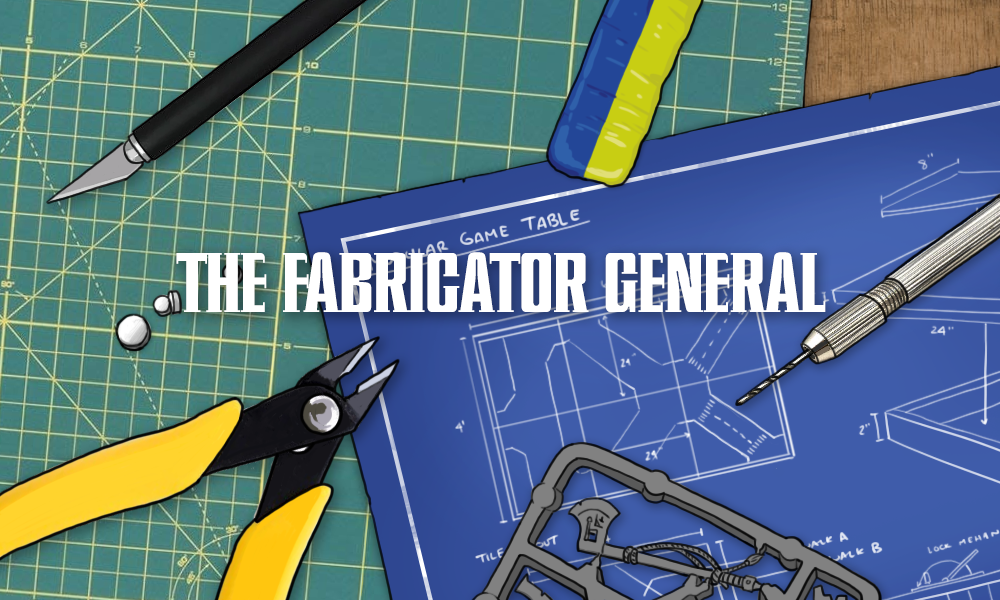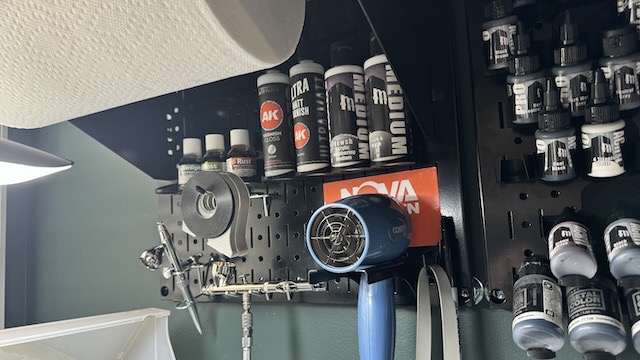In this special edition of How to Paint Everything, the Go On, Hammer! Team discusses the process in creating an efficient and well set up painting area. While not entirely unrelated to painting, this is a different aspect that is less focussed on.
I love painting. But I haven’t always. When I first got into the hobby, I struggled largely from having a non-permanent hobby space that I would need to set up to then break down at the start and end of each painting session. It became a huge block for me and it made it too easy to make excuses. After a long day I just couldn’t find the energy to set up and then just learn how (still learning) to paint when I could just sit on the couch and turn on a show.
In 2021, I made the switch from a city apartment to a suburban home which came with the opportunity to have a permanent workspace as part of my office set up. But as if a money paw curled, the space also came with a unique set of challenges that called for a creative solution. It’s been a process over the past ~3 years but I’m really happy with my workflow and what I’ve done to make my workspace my own. In my opinion, the primary objective of a good workspace is to remove any barrier that prevents you from painting but it takes time, effort, and often money to get it just right.
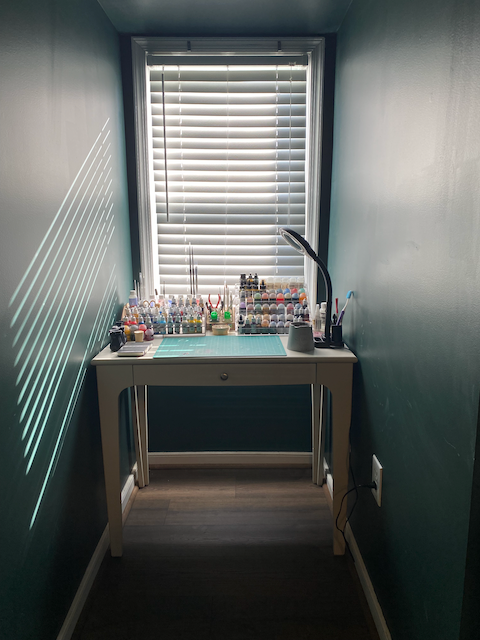
Starting Somewhere
After moving into said suburban house and claiming a room to be where I’d 1) make money and 2) spend all said money on Horus Heresy and related hobbies, I knew that the space would only work for me if I took advantage of the walls and did everything I can to prevent an immediate sense of claustrophobia.
This space has the following dimensions:
- Height: 78″
- Width: 37″
- Depth: 60″
And barely fit the Lomarp desk which was literally the only option that I could find that was deep enough to hold an airbrush booth while narrow enough to actually fit the space. It’s small and I wouldn’t be surprised if I’m the only person on the planet who uses this for painting miniatures (if you use one, please comment below). But in order to make the airbrush booth fit, I had to get my paints off my desk. Following the natural progress of a hobby space, I purchased the popular MDF paint rack.
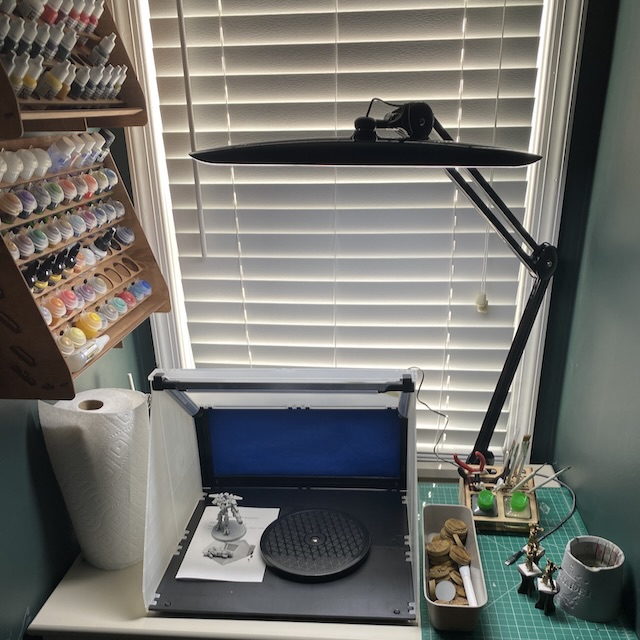
The racks are fine but soon enough, I was again running out of space. I decided to learn to airbrush (I highly recommend) but an airbrush means separate primers, cleaners, gloves, and most importantly, a respirator. I couldn’t keep everything on this little desk or if I did, I’d never actually have the space to get any painting done. Additionally, I was also increasing my collection of paint and the MDF racks were hitting a limit.
I couldn’t just add more MDF racks as they stick out quite far from the wall. Painting in a space that is 37 inches wide, I needed as much as possible to not feel trapped at the desk. If I did increase the number of racks on the wall, I probably wouldn’t want to sit down and paint in the first place, negating the entire purpose of a nice and permanent workspace. I had to figure something out. To Amazon I go.
Enter Pegboards
I found the solution and simply put, its awesome. In no way did I reinvent the wheel here but I had to turn a casual hobbyspace into a proper (kinda) workshop and step up the build quality of my setup. I came across Wall Control Pegboards and immediately ordered three. They take standard pegboard hooks, shelves, and other accessories and sit flush against the wall without sacrificing a ton of space. I can have a full pegboard next to me and I don’t feel crushed or claustrophobic. Huge win.
I also came across some higher quality “MDF-like” racks from Frontier Wargaming and while they look great, they are just not very efficient in holding paints. I will say that the variety of different things that they can hold do allow me to keep some of the more uniquely shaped painting products like enamels or oils close by. But ultimately the amount of paints held relative to the space they take up on a wall make them difficult to fully recommend. Stick with the peg boards.
Spring Cleaning
As the New Year hit and I began my “New Year, New Army,” I was looking to make some workspace improvements. I was nearly out of space for paints and I had gotten to a point that many of the things nearest to me were no longer the things that I wanted to have at hand. Out with the old and in with the new, I gave away a lot of paint to local hobbyists and largely moved to ProAcryl as my daily driving paint range. Anecdotally, dropping for the most part to a single range has been a huge improvement to my workflow as I’ve cut out a lot of analysis paralysis in searching for the “perfect” shade of color and worked within the boundaries of a single brand and its offering.
To further improve my workflow, I wanted to get those paints closer by and at an angle that made it easier to see the majority of my available selection at once. This meant shifting some of the tools to rest over my desk replacing the previously shown MDF racks and moving my paints immediately to my right when sitting at my desk. This way, I can more easily see the range of shades and quickly make decisions while in the middle of a session.
I found some great printed paint holders on Etsy and spent about two weeks moving my set up around to its current form. So far, as I continue to work on my latest project, I am absolutely loving my workspace. I have what I need right at hand (airbrush, most often used paints, and other equipment) while removing a bunch of inefficiencies from my workflow to make it easy to start painting and even easier to keep painting. To date, I’ve painted more in 2024 than I did for almost all of 2023. I call that a win.
My Current Set Up
When sitting in my chair and looking at my Workspace, it flows like this. From the left I have a cork board where I’ll put guides and other references that I may be using for a particular project. Next is my first pegboard that holds my airbrush primers, glues, water, cleanser, and other random things that I don’t really use for painting but are part of my regular workflows.
I additionally have some 3d printed paint racks that hold every paint bottle size that I use. There’s a mix of inks, contrasts, washes, mediums, weathering pigments, and decal applicators in here. I have a lot of left over space intentionally to add new products that I’m testing and later decide where to stash them later. Finally, i have three different cups of cheap paint brushes, dry brushes, and make up sponges for working with oils.
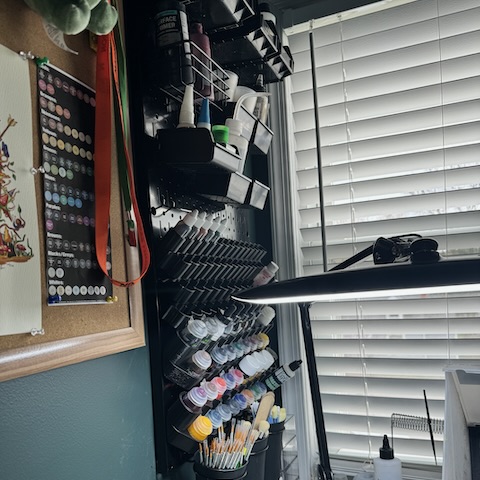
Next is my actual desk where I have my airbrush booth, and my “planned recipe paints” for whatever project I’m working on. After doing a test model, I keep the colors that I’m sure that I’ll throughout a project here where they will stay for multiple paint sessions. Once I’m done I’ll move the paints back to their respective places on my pegboards and the cycle begins again.
In the drawer I have an organized (kinda) grouping of qtips, xacto knifes, paint brushes, and other stuff that just won’t find a better place up on the walls. I also have a vortex mixer, a paintbrush drying rack, and a couple chemicals that I’m always using like airbrush thinner and flow improver. They are all easily at reach and keep me working towards my goal.
My toxic painting trait and probably a red flag for many of Goonhammer’s readers is that 99% of the time, I’m using a dry pallet. I own wet pallets (many of them) but I feel like I’m always spending more time maintaining them than they are worth. I don’t do a lot of custom blends so I’m not very worried about keeping a drop of paint alive for hours. So as you can see, my dry pallet stays in the drawer and I leave it open while painting.
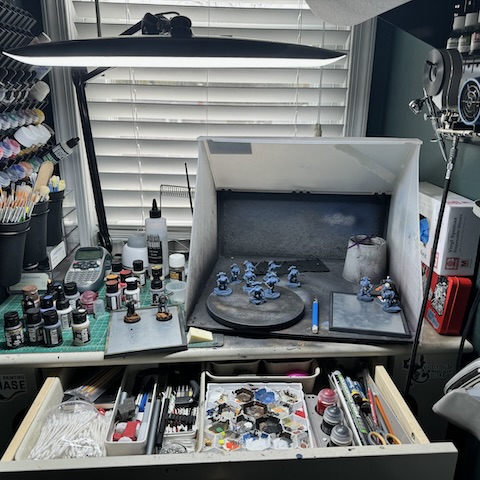
To my right, I have two more pegboards. The first, which hangs over my desk, holds my airbrush, a hair dryer, paper towels, and a couple other mediums and weathering products that didn’t have a better place to go. All of which I want on hand but are not immediately next to me as I don’t stare in this place for inspiration. I know what’s here and I can reach for what I need without really looking.
Above the paper towels is a half pegboard of paint racks meant to hold Vallejo, Two Thin Coats, and other similarly sized bottles. I have some other tools in bins but largely this is where I keep things that I don’t need very often. These paints are accessible but I need to stand to reach them and basically will move them from storage to my desk and vice versa. I also keep some specialty ProAcryl paints here like their Transparent and Fluorescent ranges. I know this is where they live and if I need them, I know exactly where to look. They also don’t get mixed in with the other acrylics this way.
Next up, I have my “paint board” which is immediately to my right when sitting down. It holds all the standard ProAcryl paints and a bunch of metallics from various ranges. I purposely moved all of these here so I have better visibility to the variety of colors and when I’m “stuck”, I just look over and try to find something that sparks my interest. I swap paints in and out from here constantly and while I keep my repeated / planned recipe paints on my desk, I will often look up and grab a lighter or darker shade to close out whatever part of a mini that I’m working on. It’s simple, but this change has been the most impactful to how I paint minis.
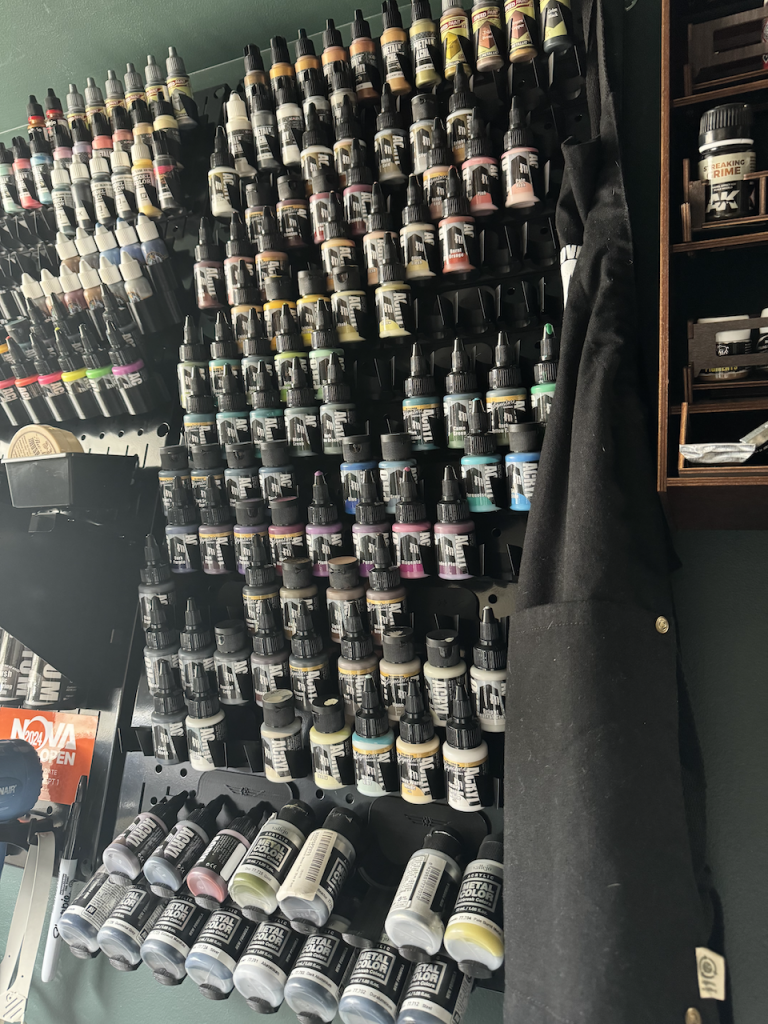
Finally, to the right of my paint board, I have the previously mentioned Wall Rack from Frontier Wargaming. As you can see it holds a lot less than a pegboard for its total footprint but I do appreciate and take advantage of its ability to hold a variety of products. These are all “random” products that I will dabble with from project to project such as enamels, oils, weathering pigments, and GW washes.
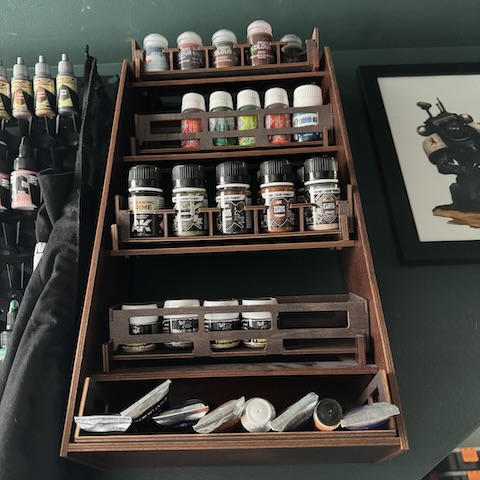
Wrapping Up
I know there is a lot of “stuff” here, but I think I’ve done a good job in making the most out of my little space and have found a workflow that not only keeps me painting, but also helps me have a lot more fun while painting too. I can wrap up a work call and block in some colors within minutes and just as easily walk away, leaving my current mini to continue another day.
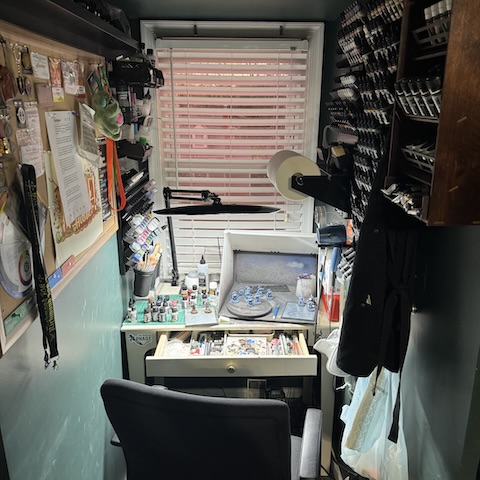
Ultimately the build of my workspace has become incredibly personal and has shifted based on the tools I work with and the projects that I work on. I highly recommend that you also take a look at how you paint and then try to adjust your workspace to maximize your enjoyment while removing the things that get in the way. You’ll paint more often and have fun doing which will ultimately result in you becoming a better painter too.
